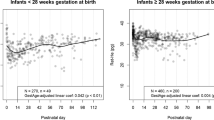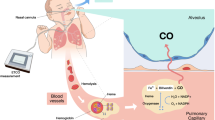Abstract
Objective:
To measure systemic haptoglobin (HPT) concentrations from birth in preterm (PT) and T newborns. To compare HPT in newborns without hemolysis or infection with values in bacteremic newborns.
Study Design:
HPT was measured using enzyme-linked immunosorbent assay in 30 PT and 28 T newborns without hemolysis or infection at birth (cord blood), on days of life 2 to 4, and at 1 to 2 weeks of life. Concentrations were measured in eight additional newborns with bacteremia. Wilcoxon–Mann–Whitney test was used for comparisons.
Result:
HPT concentrations were consistently measurable from birth in PT and T neonates. Values were significantly greater in 2- to 4-day-old PT and T newborns than in newborns at birth (P<0.01). Bacteremic newborns had higher HPT concentrations than newborns without infection (P=0.033).
Conclusion:
HPT is detectable from birth in PT and T newborns. HPT concentrations increase in bacteremic newborns. HPT levels may have clinical utility in the evaluation of neonatal sepsis.
This is a preview of subscription content, access via your institution
Access options
Subscribe to this journal
Receive 12 print issues and online access
$259.00 per year
only $21.58 per issue
Buy this article
- Purchase on Springer Link
- Instant access to full article PDF
Prices may be subject to local taxes which are calculated during checkout

Similar content being viewed by others
References
Wicher KB, Fries E . Haptoglobin, a hemoglobin-binding plasma protein, is present in bony fish and mammals but not in frog and chicken. Proc Natl Acad Sci USA 2006; 103 (11): 4168–4173.
Levy AP, Asleh R, Blum S, Levy NS, Miller-Lotan R, Kalet-Litman S et al. Haptoglobin: basic and clinical aspects. Antioxid Redox Signal 2010; 12 (2): 293–304.
Kristiansen M, Graversen JH, Jacobsen C, Sonne O, Hoffman HJ, Law SK et al. Identification of the haemoglobin scavenger receptor. Nature 2001; 409 (6817): 198–201.
Sadrzadeh SM, Bozorgmehr J . Haptoglobin phenotypes in health and disorders. Am J Clin Pathol 2004; 121 (Suppl:S9): 7–104.
Marchand A, Galen RS, Van Lente F . The predictive value of serum haptoglobin in hemolytic disease. JAMA 1980; 243 (19): 1909–1911.
Kormoczi GF, Saemann MD, Buchta C, Peck-Radosavljevic M, Mayr WR, Schwartz DW et al. Influence of clinical factors on the haemolysis marker haptoglobin. Eur J Clin Invest 2006; 36 (3): 202–209.
Yee BL, Bollard CM GS . Appendix: normal blood values: selected reference values for neonatal, pediatric, and adult populations. In: Hoffman R Benz EJ SS, Furie B, Silberstein LE, McGlave P, Heslop H, Anastasi J, (eds). Hoffman: Hematology: Basic Principles and Practice. Churchill Livingstone Elsevier: Philadelphia, PA, 2008. pp 2431–2442.
Shinton NK, Richardson RW, Williams JD . Diagnostic value of serum haptoglobin. J Clin Pathol 1965; 18: 114–118.
Kanakoudi F, Drossou V, Tzimouli V, Diamanti E, Konstantinidis T, Germenis A et al. Serum concentrations of 10 acute-phase proteins in healthy term and preterm infants from birth to age 6 months. Clin Chem 1995; 41 (4): 605–608.
Cakmak A, Calik M, Atas A, Hirfanoglu I, Erel O . Can haptoglobin be an indicator for the early diagnosis of neonatal jaundice? J Clin Lab Anal 2008; 22 (6): 409–414.
Liberatori S, Bini L, De Felice C, Magi B, Marzocchi B, Raggiaschi R et al. Acute-phase proteins in perinatal human plasma. Electrophoresis 1997; 18 (3–4): 520–526.
Arnon S, Litmanovitz I . Diagnostic tests in neonatal sepsis. Curr Opin Infect Dis 2008; 21 (3): 223–227.
Benitz WE, Han MY, Madan A, Ramachandra P . Serial serum C-reactive protein levels in the diagnosis of neonatal infection. Pediatrics 1998; 102 (4): E41.
Haque KN . Defining common infections in children and neonates. J Hosp Infect 2007; 65 (Suppl 2): 110–114.
Linder N, Arad I . Plasma haptoglobin levels in vacuum extracted neonates. J Perinat Med 1984; 12 (1): 35–37.
Orro T, Jacobsen S, LePage JP, Niewold T, Alasuutari S, Soveri T . Temporal changes in serum concentrations of acute phase proteins in newborn dairy calves. Vet J 2008; 176 (2): 182–187.
Turner D, Hammerman C, Rudensky B, Schlesinger Y, Goia C, Schimmel MS . Procalcitonin in preterm infants during the first few days of life: introducing an age related nomogram. Arch Dis Child Fetal Neonatal Ed 2006; 91 (4): F283–F286.
Oliviero S, Cortese R . The human haptoglobin gene promoter: interleukin-6-responsive elements interact with a DNA-binding protein induced by interleukin-6. EMBO J 1989; 8 (4): 1145–1151.
Kishimoto T, Akira S, Narazaki M, Taga T . Interleukin-6 family of cytokines and gp130. Blood 1995; 86 (4): 1243–1254.
Cancelier AC, Petronilho F, Reinke A, Constantino L, Machado R, Ritter C et al. Inflammatory and oxidative parameters in cord blood as diagnostic of early-onset neonatal sepsis: a case-control study. Pediatr Crit Care Med 2009; 10 (4): 467–471.
Santana C, Guindeo MC, Gonzalez G, Garcia-Munoz F, Saavedra P, Domenech E . Cord blood levels of cytokines as predictors of early neonatal sepsis. Acta Paediatr 2001; 90 (10): 1176–1181.
Kurt AN, Aygun AD, Godekmerdan A, Kurt A, Dogan Y, Yilmaz E . Serum IL-1beta, IL-6, IL-8, and TNF-alpha levels in early diagnosis and management of neonatal sepsis. Mediators Inflamm 2007; 2007: 31397.
Moestrup SK, Moller HJ . CD163: a regulated hemoglobin scavenger receptor with a role in the anti-inflammatory response. Ann Med 2004; 36 (5): 347–354.
Nielsen MJ, Moestrup SK . Receptor targeting of hemoglobin mediated by the haptoglobins: roles beyond heme scavenging. Blood 2009; 114 (4): 764–771.
Arredouani M, Matthijs P, Van Hoeyveld E, Kasran A, Baumann H, Ceuppens JL et al. Haptoglobin directly affects T cells and suppresses T helper cell type 2 cytokine release. Immunology 2003; 108 (2): 144–151.
Arredouani MS, Kasran A, Vanoirbeek JA, Berger FG, Baumann H, Ceuppens JL . Haptoglobin dampens endotoxin-induced inflammatory effects both in vitro and in vivo. Immunology 2005; 114 (2): 263–271.
Arnon S, Litmanovitz I, Regev R, Lis M, Shainkin-Kestenbaum R, Dolfin T . The prognostic virtue of inflammatory markers during late-onset sepsis in preterm infants. J Perinat Med 2004; 32 (2): 176–180.
Ng PC, Lam HS . Diagnostic markers for neonatal sepsis. Curr Opin Pediatr 2006; 18 (2): 125–131.
Kaplan M, Hammerman C, Vreman HJ, Wong RJ, Stevenson DK . Hemolysis and hyperbilirubinemia in antiglobulin positive, direct ABO blood group heterospecific neonates. J Pediatr 2010; 157 (5): 772–777.
Kaplan M, Hammerman C, Renbaum P, Levy-Lahad E, Vreman HJ, Stevenson DK . Differing pathogenesis of perinatal bilirubinemia in glucose-6-phosphate dehydrogenase-deficient versus-normal neonates. Pediatr Res 2001; 50 (4): 532–537.
Acknowledgements
We thank Dr Kris Sekar for his thoughtful review and valuable comments to this manuscript, and Chee Yoon S Bauer for technical assistance with laboratory assays. We gratefully acknowledge the support of the Children's Medical Research Institute.
Author information
Authors and Affiliations
Corresponding author
Ethics declarations
Competing interests
The authors declare no conflict of interest.
Rights and permissions
About this article
Cite this article
Chavez-Bueno, S., Beasley, J., Goldbeck, J. et al. ‘Haptoglobin concentrations in preterm and term newborns’. J Perinatol 31, 500–503 (2011). https://doi.org/10.1038/jp.2010.197
Received:
Revised:
Accepted:
Published:
Issue Date:
DOI: https://doi.org/10.1038/jp.2010.197
Keywords
This article is cited by
-
Cardiopulmonary bypass in the newborn: effects of circulatory cell-free hemoglobin and hyperoxia evaluated in a novel rat pup model
Intensive Care Medicine Experimental (2017)
-
Extracellular hemoglobin - mediator of inflammation and cell death in the choroid plexus following preterm intraventricular hemorrhage
Journal of Neuroinflammation (2014)
-
Association between haptoglobin, hemopexin and mortality in adults with sepsis
Critical Care (2013)
-
Hemoglobin induces inflammation after preterm intraventricular hemorrhage by methemoglobin formation
Journal of Neuroinflammation (2013)
-
Haptoglobin in diagnosis of sepsis
Journal of Perinatology (2012)



